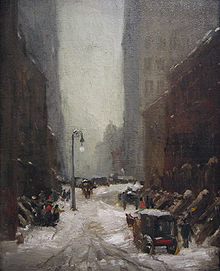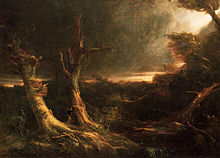- Nocturne (painting)
-
 Nocturne in Blue and Gold: Valparaiso Bay (1866) by James Abbott McNeill Whistler
Nocturne in Blue and Gold: Valparaiso Bay (1866) by James Abbott McNeill Whistler
In visual arts, nocturne painting is a visual language that is often used within realistic treatments (such as Realism and Impressionism) to depict scenes evocative of night or subjects as they appear in a veil of light, in twilight, or in the absence of direct light. Many artists develop their own methods to create nocturnes unique to their styles. The particular method or style that an artist chooses to paint a nocturne may not be limited to realism. Nocturnal depictions have also been shown within impressionist and abstract works. Nocturnes are usually, but not always, inclusive of landscapes and cover the gamut of artistic periods, generally stretching from the southern and northern Baroque period of the early 17th century to the present. Artists often use various methods to depict nocturnes: washes of color, impasto methods, and linear treatments.
Contents
Rembrandt’s nocturnes
In northern Europe, the Dutch Golden Age produced one of the greatest artists of all time. The first artist to paint scenes on a regular basis in the nocturne mode was Rembrandt van Rijn (1606–1669). Many of his portraits were also painted using a nocturne method. As in The Mill (1645), most of his landscapes were painted to evoke a sense of the nocturne, which could be expressed in either a calm or stormy manner.[1] Among Rembrandt's other nocturnes are:
-
- Christ In The Storm On The Sea Of Galilee (1633) by Rembrandt van Rijn depicts a nocturne scene evoking a sense of danger
- Christ and the Woman of Samaria (1659)[2]
- The Polish Rider (1655)[3]
Gallery of nocturnes by James Abbott McNeill Whistler
“Nocturne” was a term that was normally applied to certain types of musical compositions before James Abbott McNeill Whistler (1834–1903), inspired by the language of music, began using the word within the titles of many of his works,[4] such as Nocture in Blue and Silver[5] (1871), in the collection of the Tate Gallery, London, United Kingdom, and the following paintings that are pictured in order of date completed, left to right:
-
Nocturne in Gray and Gold, Westminster Bridge (c. 1871-1874)
 Snow in New York (1902), by Robert Henri exemplifies an urban nocturne by an American Realist. The painting is in the collection of the National Gallery of Art, Washington, D.C.
Snow in New York (1902), by Robert Henri exemplifies an urban nocturne by an American Realist. The painting is in the collection of the National Gallery of Art, Washington, D.C.
 Sunset on the Plains (1905–1906) by Frederic Remington is representative of his late Impressionistic style. The painting is in the West Point Museum Collection, United States Military Academy, New York.
Sunset on the Plains (1905–1906) by Frederic Remington is representative of his late Impressionistic style. The painting is in the West Point Museum Collection, United States Military Academy, New York.
Nocturnes by American Realists
Nocturne scenes by well-known American Realists include:
- Spanish Dancer (1879–1880), by John Singer Sargent is an example of a figurative nocturne by an American Realist, The Hispanic Society of America, New York
- Thomas Eakins (1844-1916), Hiawatha (1870)[6]
- Robert Henri (1865-1929, Snow in New York (1902), National Gallery of Art, Washington, D.C.
Nocturnes by American Impressionists
Nocturne scenes by imminent American Impressionists include:
-
- Childe Hassam (1859-1935), Fifth Avenue Nocturne,[7] (ca. 1895), The Cleveland Museum of Art, Ohio
- Childe Hassam, Late Afternoon,[8] New York, Winter (1900), Brooklyn Museum of Art
- Childe Hassam, Broadway and 42nd Street,[9] (1902), Metropolitan Museum of Art, New York]
- Willard Metcalf (1858-1825), May Night (1906)[10]
- J. Alden Weir (1852-1919), The Bridge: Nocturne (Nocturne: Queensboro Bridge),[11] (1910), Hirshhorn Museum and Sculpture Garden, Washington D.C.
- J. Alden Weir, The Plaza: Nocturne,[12] (1911), Hirshhorn Museum and Sculpture Garden, Washington D.C.
Frederic Remington’s nocturnes
Frederic Remington (1861-1909) is so identified for his nocturne scenes of the American Old West[13] that they were celebrated in 2003-2004 with an exhibition, Frederic Remington: The Color of Night, co-organized and shown in turn by the National Gallery of Art, Washington, D.C., and the Gilcrease Museum, Tulsa, Oklahoma.[14] The exhibition also generated a colorful book of the same title[15] and travelled to the Denver Art Museum in Denver, Colorado. Remington painted many of his nocturnes in the last years of his life, when he was transitioning from a career as an illustrator to that of a fine artist and had chosen Impressionism as the style in which he worked at the time. One example of his work is The Stampede (also known as The Stampede by Lightning, 1908).
Gallery of nocturnes by Frederic Remington
The paintings pictured in the gallery below are in order of date completed, left to right:
-
The End of the Day (circa 1904), Frederic Remington Art Museum, Ogdensburg, New York
-
Shotgun Hospitality (1908), Hood Museum of Art, Dartmouth College, Hanover, New Hampshire
-
The Hunters' Supper (circa 1909), National Cowboy & Western Heritage Museum, Oklahoma City, Oklahoma
Nocturnes by artists of other movements
 The Tornado (1835) by Thomas Cole, the founder of the Hudson River group of landscape painters in 1825, which dominated the landscape movement in America until the 1870s
The Tornado (1835) by Thomas Cole, the founder of the Hudson River group of landscape painters in 1825, which dominated the landscape movement in America until the 1870s
Other artists who also created nocturne scenes are:
- Jacob van Ruisdael (1628–1682), Landscape with Church (circa 1660)]
- Jacob van Ruisdael, Landscape (circa 1665)
- Thomas Cole (1801–1848), Moonlight (1833–34)
- Thomas Cole, The Tornado (1835)
- Augustus Leopold Egg (1816–1863), Past and Present Number Three (circa 1853)]
- George Inness (1825-1894), Pool in the Woods (1892), Worcester Art Museum, Worcester, Massachusetts
- John LaFarge (1835-1920), The Lady of Shalott (1862)[16]
- Edgar Degas (1834–1917), Interior (nicknamed The Rape) (1868–69),[17] Philadelphia Museum of Art
- John Henry Twachtman (1853-1902), Canal Venice[18] (circa 1878), private collection
- John Henry Twachtman (1853–1902), L'Etang[19] (circa 1884), private collection
- Vincent van Gogh (1853-1890), Starry Night Over the Rhone (1888)[20]
- Albert Pinkham Ryder (1847–1917), Death on a Pale Horse (The Race Track)[21] (circa 1910), The Cleveland Museum of Art, Ohio
- Frank Tenney Johnson (1874-1939), Rough Riding Rancheros[22] (c. 1933)
Further reading
- Holden, Donald. Whistler: Landscapes and Seascapes. Lakewood, New Jersey: Watson-Guptill Publications, 1984.
- Anderson, Nancy with Alexander Nemerov and William Sharpe. Frederic Remington: The Color of Night. Washington, D.C.: National Gallery of Art, 2003.
- Sharpe, William C. New York Nocturne: The City After Dark In Literature, Painting, and Photography, 1850-1950. Princeton, New Jersey: Princeton University Press, 2008.
- Simpson, Marc and others. Like Breath on Glass: Whistler, Inness, and the Art of Painting Softly. Williamstown, Massachusetts: Sterling and Francine Clark Art Institute, 2008 (printed by Yale University Press).
References
- ^ Images of Rembrandt's landscape paintings
- ^ Backtoclassics.com
- ^ Collections.frick.org
- ^ Images of many of Whistler's nocturne paintings, and some by his contemporaries, can be seen at this website for the Detroict Institute of Arts
- ^ Tate.org
- ^ Tamsquare.net
- ^ Jimloy.com
- ^ Jimloy.com
- ^ Jimloy.com
- ^ Flickr.com
- ^ Hirshhorn.si.edu
- ^ Hirshhorn.si.edu
- ^ 18 images of Remington’s nocturnes on 18 web pages at the National Gallery of Art
- ^ The Color of Night exhibition website with extensive information and images about Frederic Remington and his paintings
- ^ Nancy Anderson with Alexander Nemerov and William Sharpe. Frederic Remington: The Color of Night. National Gallery of Art, Washington, D.C., 2003
- ^ Victorianweb.org
- ^ Jimloy.com
- ^ Johnhtwachtman.com
- ^ Artnet.com
- ^ Essentialart.com
- ^ Interactive.usc.edu
- ^ Cowboyindian.com
Categories:- Painting
- Painting techniques
- Artistic techniques
- Art genres
-
Wikimedia Foundation. 2010.











